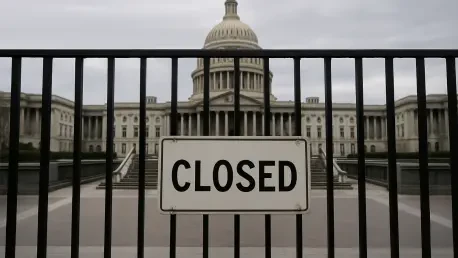As the federal government grapples with a funding lapse, the clean energy sector in the United States stands on shaky ground, facing potential setbacks that could ripple across projects and policies, casting a shadow over critical initiatives aimed at advancing renewable energy and sustainability. This ongoing shutdown, driven by unresolved budget disputes in Congress, has created uncertainty for developers, corporate stakeholders, and federal agencies alike, with delays in permitting, regulatory guidance, and grant allocations threatening to stall momentum. The implications are far-reaching, as timely governmental action often serves as the backbone for clean energy innovation and deployment. With key agencies forced to scale back operations, the question looms: how long can the sector withstand these disruptions before lasting damage is done?
Impacts on Federal Agencies and Operations
Immediate Disruptions to Key Energy Departments
The current government shutdown has swiftly impacted several federal agencies pivotal to clean energy progress, creating immediate operational hurdles. The Department of Energy (DOE), Department of the Interior (DOI), Environmental Protection Agency (EPA), Federal Energy Regulatory Commission (FERC), and the U.S. Army Corps of Engineers are among those facing significant constraints. While essential functions tied to public safety and grid reliability remain active, non-essential tasks such as issuing new permits and processing grants have ground to a halt. For instance, renewable energy projects under the Bureau of Ocean Energy Management (BOEM) are effectively paused, stalling offshore wind and other initiatives. This sudden stoppage disrupts timelines for developers who depend on federal approvals to move forward, highlighting the fragility of project pipelines during such funding lapses. The varying degrees of impact across agencies underscore the uneven burden placed on the clean energy sector, with some areas more vulnerable than others to these interruptions.
Essential Functions versus Non-Essential Delays
Beyond the immediate freeze on certain operations, a clear distinction emerges between essential and non-essential activities within affected agencies. Critical safety and emergency functions, such as those ensuring grid stability at FERC, continue under contingency plans, providing a thin layer of protection against total paralysis. However, non-essential efforts—particularly those related to renewable energy permitting and interagency coordination at the EPA—are suspended indefinitely. At the DOI, while some oil and gas infrastructure activities may persist under prior emergency declarations, renewable energy projects lack similar exemptions, placing them at a distinct disadvantage. This imbalance not only delays specific initiatives but also risks skewing the broader energy landscape by prioritizing fossil fuel-related actions over sustainable alternatives. If the shutdown persists, the backlog of delayed approvals and stalled collaborations could create long-term bottlenecks for clean energy advancement.
Broader Implications for Clean Energy Stakeholders
Delays in Regulatory Guidance and Tax Processes
For clean energy developers and corporate tax credit buyers, the shutdown introduces significant uncertainty around regulatory guidance and financial planning. A key concern is the anticipated guidance from the Internal Revenue Service (IRS) on Foreign Entities of Concern (FEOC) provisions, which developers urgently need to navigate compliance and project structuring. Furloughs at the Office of Management and Budget (OMB) and other supporting agencies threaten to delay this critical release, leaving stakeholders in limbo. Meanwhile, the IRS has maintained most operations for now, ensuring that tax filing processes, including the upcoming extended deadline, remain accessible. Many companies relying on transferable tax credits for this year appear to have secured necessary pre-filing registration numbers, with the registration portal expected to stay active during a brief shutdown. Nonetheless, any extension of the funding lapse could erode even this temporary stability, complicating financial strategies for clean energy investments.
Long-Term Risks of Prolonged Shutdowns
If the current shutdown extends beyond a short-term disruption, the clean energy sector faces escalating risks that could undermine years of progress. Historical precedents, such as the longest recorded shutdown lasting 35 days, illustrate how prolonged lapses can wreak havoc on federal operations and stakeholder confidence. Current agency staffing levels, already lower than earlier this year, complicate the execution of contingency plans, making outcomes harder to predict. Additionally, potential reductions in force, as proposed by OMB leadership, could further cripple energy-related functions if implemented mid-shutdown. Public equity and debt markets have yet to react strongly, but sustained economic harm from an extended lapse could shift investor sentiment, drying up capital for renewable projects. For developers and investors, the mounting uncertainty around permitting and grantmaking delays could derail project timelines and financial viability, casting a long shadow over the sector’s ability to meet ambitious sustainability goals in the coming years.
Navigating an Uncertain Future for Clean Energy
Reflecting on the challenges posed by the government shutdown, it becomes evident that the clean energy sector has encountered a formidable obstacle in maintaining its forward momentum. The disruptions to federal agencies, coupled with looming delays in regulatory guidance, have placed developers and stakeholders in a precarious position, forcing many to reassess timelines and strategies. Looking ahead, actionable steps emerge as vital to mitigate such setbacks in future scenarios. Strengthening contingency frameworks within agencies to prioritize renewable energy initiatives, even during funding lapses, stands out as a critical need. Additionally, fostering greater collaboration between private stakeholders and state-level authorities could provide a buffer against federal interruptions. Advocating for streamlined permitting processes and emergency funding allocations for clean energy projects is seen as a proactive measure to safeguard progress, ensuring that the path to sustainability remains resilient against political and budgetary turbulence.









